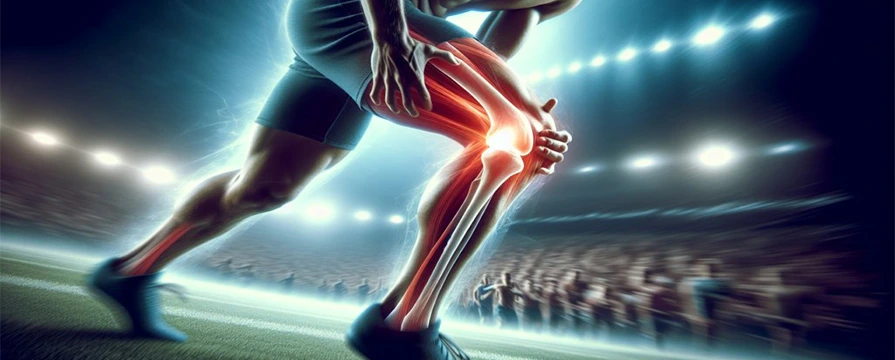Whether you play sports or have an active lifestyle taking care of your knees is crucial to avoiding injuries and preserving your long-term health. One of the body’s most intricate and often utilized joints the knee supports both daily tasks and strenuous physical activity such as athletics. Running, jumping, fast turns and abrupt stops are just a few of the activities that put a great deal of strain on the knee and increase its risk of injury. Ignoring a small ache or discomfort now could lead to big issues later on and impair your daily mobility or sports ability.
In addition to being excruciating, knee ailments like ligament rips, tendonitis or cartilage degradation can also necessitate surgery in certain situations and have protracted recovery times. Early detection of knee problems such as swelling, instability, or chronic discomfort can have a major impact on healing. Proactive Knee Care is essential for preventing injuries this includes stretching strengthening exercises and using the right form when playing sports. To prevent aggravating the injury you should speak with a medical expert if your discomfort lasts longer than expected.
The top 5 knee ailments that athletes most frequently experience will be covered in this article along with practical preventative techniques to ensure optimal knee care. Whether you like to jog or play high-impact sports like basketball knowing these injuries and how to avoid them will help you stay pain-free and active for a long time.
Here are the Top 5 Knee Injuries in Athletes and How to Prevent Them
1. Patellar Fracture:
A significant injury known as a patellar fracture is sustained when the kneecap breaks frequently as a result of a direct hit, fall or overuse. This kind of injury can seriously limit knee function and range of motion. Fractures can range in severity from tiny cracks to full breaks where the bone is misplaced. Patellar fractures are especially common in athletes who play high-impact sports or engage in other activities that put an excessive amount of stress on their knees. Depending on the complexity of the fracture immediate treatment and maybe surgery are frequently needed to restore complete function and avoid long-term problems.
2. Knee Dislocation:
When the bones that make up the knee joint are knocked out of alignment, it is known as a knee dislocation. This usually happens as a result of high-impact injuries or abrupt direction shifts. There are two types of this type of injury low-velocity more prevalent in sports like soccer gymnastics and skiing and high-velocity typically resulting from severe trauma like auto accidents. When a knee dislocates athletes may suffer from excruciating pain swelling and loss of knee mobility. Realigning the knee is a common part of treatment which is followed by rehabilitation to regain strength and stability.
3. Patellar Tendonitis:
The overuse ailment known as “jumper’s knee” or patellar tendonitis results in discomfort and inflammation in the tendon that connects the kneecap to the shinbone. Those who play sports like basketball volleyball or long jump which involve quick forceful motions or jumping are especially vulnerable. The injury appears gradually and if treatment is not received the initial mild symptoms may get worse over time. Microtears which produce discomfort and inflammation are the result of the tendon being repeatedly stressed. Patellar tendinitis can worsen and result in long-term problems if sufficient rest and therapy are not received.
4. Meniscal Injury:
The meniscus a portion of knee cartilage that serves as a cushion between the thigh and shin bones can tear in a meniscal injury. This injury frequently results from abrupt turns, pivots or injuries to the knee particularly in sports like basketball skiing or football. The tear can be minor to severe in severity, and it can happen in addition to other knee problems such ligament tears. Inflammation discomfort and limited knee mobility are among the symptoms. Treatment options can include physical therapy, rest and surgery depending on the severity.
5. Osgood-Schlatter Disease:
Adolescents with Osgood-Schlatter Disease an overuse condition are frequently affected by growth spurts. It produces discomfort and inflammation where the patellar tendon attaches at the tibial tuberosity which is located directly below the kneecap. This illness is frequently observed in young athletes who play sports like basketball or soccer that call for quick changes in direction or running. Usually the discomfort gets worse while you move and gets better when you relax. Even though it is a transient state until growth plate closure it might be uncomfortable and restrict sports participation.
Conclusion
In conclusion, sportsmen frequently worry about knee injuries which are frequently brought on by the extreme physical strain that different activities exert on the joint. Good awareness and preventative actions are crucial for maintaining optimal knee health, from severe injuries like patellar fractures and dislocations to overuse ailments like patellar tendinitis and Osgood-Schlatter disease. In order to treat these injuries early and prevent long-term damage as well as to ensure that athletes can resume their activities without a large amount of downtime, it is essential to understand the origins, symptoms and treatments of these injuries.
The risk of injury can be significantly decreased by putting the necessary Knee Care practices into practice such as strengthening exercises, stretching and adopting the right techniques when playing sports. Preventing common concerns such as knee joint overuse, early treatment of discomfort and routine check-ups are essential. Whether you lead an active lifestyle or are a professional athlete maintaining your knee health can guarantee continued joint health and optimal physical performance.




